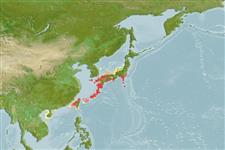>
Gobiiformes (Gobies) >
Gobiidae (Gobies) > Gobiinae
Etymology: Eviota: No etymology given, suggested by Christopher Scharpt: from Latin 'eu' for 'true' and 'iota' for anything very small, in combination 'truly very small' referring to it as being the smallest vertebrate at the time it has benn described by Jenkins (thus, making the suggestion by Scharpt plausible; rubrimaculata: Name as an adjective from the Latin 'rubra' for red and 'macula' for spot; referring to the
distinctive red spots on the head and body.
Environment: milieu / climate zone / depth range / distribution range
Ecologie
marien rifbewoner; diepte 6 - 8 m (Ref. 104430). Subtropical
Verspreiding
Landen | FAO regio's | Ecosystemen | Voorkomen | Point map | Introducties | Faunafri
Northwest Pacific: Ryukyu Is., Japan.
Grootte / Gewicht / Leeftijd
Maturity: Lm ? range ? - ? cm
Max length : 1.2 cm SL (female)
Korte beschrijving
Determinatiesleutels | Morfologie | Morfometrie
Dorsale stekels (totaal) : 7; Dorsale zachte stralen (totaal) : 9; Anale stekels: 1; Anale zachte stralen: 8. This species is distinguished by the following characters: cephalic sensory-canal pore system pattern 2 (lacking only H [IT] pore); some pectoral-fin rays branched (11-15th rays); dorsal/anal fin-ray formula 9/8; absence of the 5th pelvic-fin ray; absence of the following - prominent distinct dark spots on pectoral-fin base, caudal-peduncle spot over preural centrum, postocular spots, and the strong and dark spots on caudal fin; anal-fin base with 2 dark spots; first dorsal fin clear with some light orange on anterodorsal portion and dark distal margin; second dorsal fin with red-orange spots on basal half, distal margin black and yellow; the body with bright red markings (Ref. 104430).
Levenscyclus en paargedrag
Maturiteit | Voortplanting | Paaien | Eieren | Fecunditeit | Larven
Suzuki, T., D.W. Greenfield and H. Motomura, 2015. Two new dwarfgobies (Teleostei: Gobiidae) from the Ryukyu Islands, Japan: Eviota flavipinnata and Eviota rubrimaculata. Zootaxa 4007(3):399-408. (Ref. 104430)
Status op de Rode Lijst van het IUCN (Ref. 130435: Version 2024-1)
Gevaar voor de mens
Harmless
Gebruik door de mens
Tools
Speciale rapporten
Download XML
Internetbronnen
Estimates based on models
Fylogenetische diversiteitsindex (Ref.
82804): PD
50 = 0.5000 [Uniqueness, from 0.5 = low to 2.0 = high].
Bayesian length-weight: a=0.00692 (0.00284 - 0.01683), b=3.10 (2.92 - 3.28), in cm total length, based on LWR estimates for this Genus-body shape (Ref.
93245).
Trofisch niveau (Ref.
69278): 2.9 ±0.3 se; based on size and trophs of closest relatives
Weerstandsvermogen (Ref.
120179): Hoog, minimale populatieverdubbelingstijd minder dan 15 maanden (Preliminary K or Fecundity.).
Fishing Vulnerability (Ref.
59153): Low vulnerability (10 of 100).
